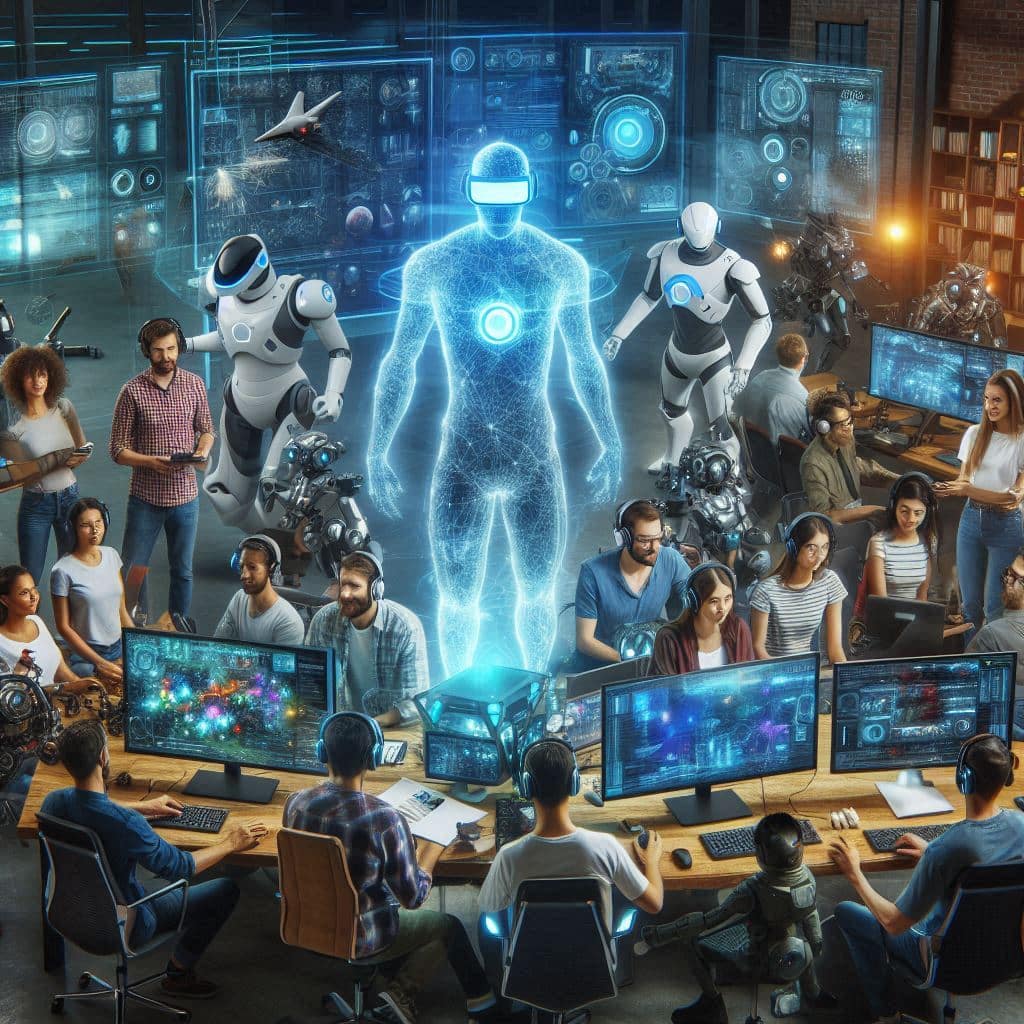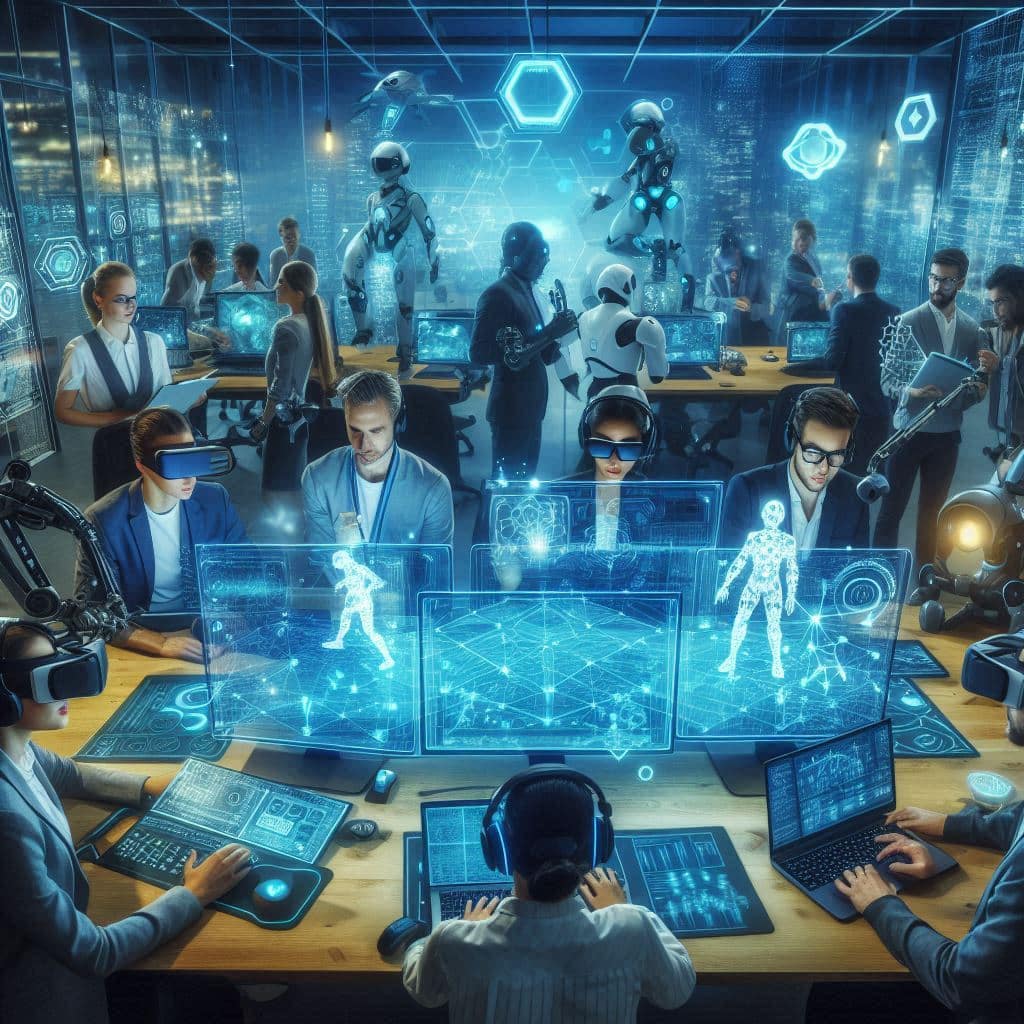The game development landscape is constantly evolving, driven by rapid technological advancements and innovative trends. From augmented reality (AR) to artificial intelligence (AI), the future of game development promises to be even more exciting and immersive. In this article, we’ll explore the emerging technologies and trends that are set to shape the next generation of game development.

1. Virtual Reality (VR) and Augmented Reality (AR)
The Technology:
VR and AR are transforming the gaming experience by creating immersive, interactive environments. VR places players in fully digital worlds, while AR overlays digital elements onto the real world.
Read More: Exploring Augmented Reality (AR) in Game Development(Opens in a new browser tab)
How It’s Shaping the Future:
As VR and AR technologies advance, games will become more engaging and lifelike. Improved hardware and software will make these experiences more accessible and appealing to a broader audience.
Use Case Scenario:
Imagine playing a VR adventure game where you physically move through a fantasy world, interacting with characters and solving puzzles. Alternatively, an AR game could turn your living room into a battlefield where you strategize and defend against virtual enemies.
2. Artificial Intelligence (AI)
The Technology:
AI is enhancing game development by creating smarter, more responsive NPCs (non-player characters) and providing dynamic, personalized gaming experiences.
How It’s Shaping the Future:
AI will enable more complex behaviors and interactions within games. Adaptive AI can learn from player actions, offering customized challenges and storylines that evolve based on individual playstyles.
Read More: The Impact of AI on Game Development: A New Era of Gaming(Opens in a new browser tab)
Use Case Scenario:
In a strategy game, AI-controlled opponents could analyze your tactics and adapt their strategies, providing a unique and challenging experience each time you play. Additionally, AI-driven storylines could change based on your decisions, making each playthrough different.
3. Cloud Gaming
The Technology:
Cloud gaming allows players to stream games directly from the cloud, eliminating the need for high-end hardware.
How It’s Shaping the Future:
With cloud gaming, high-quality gaming experiences will be accessible to more people, regardless of their device’s capabilities. This technology also enables instant access to games without lengthy downloads or updates.
Use Case Scenario:
Services like Google Stadia and NVIDIA GeForce NOW already offer cloud gaming, allowing players to enjoy graphically intensive games on low-end devices like smartphones or tablets. As the technology improves, expect more seamless and widespread adoption.
4. Procedural Generation
The Technology:
Procedural generation uses algorithms to create vast, dynamic game worlds and content on the fly, providing endless possibilities and replayability.
How It’s Shaping the Future:
Games will feature more diverse and expansive worlds with unique environments, quests, and challenges each time you play. This can greatly enhance the longevity and replay value of games.
Use Case Scenario:
Games like “No Man’s Sky” use procedural generation to create an entire universe with billions of unique planets to explore. Future games could take this even further, offering ever-changing landscapes and adventures.
5. Haptic Feedback and Wearable Technology
The Technology:
Haptic feedback and wearable technology provide tactile sensations, enhancing the physicality and immersion of gaming experiences.
How It’s Shaping the Future:
As haptic technology improves, players will feel more connected to the game world through realistic touch sensations. Wearable devices could track player movements and biometrics, offering deeper interactivity and immersion.
Use Case Scenario:
Imagine a racing game where you feel the vibrations and impacts of the car through haptic feedback gloves or a vest. Or a fitness game that monitors your heart rate and adjusts the difficulty to match your physical performance.
6. Blockchain and NFTs
The Technology:
Blockchain technology and non-fungible tokens (NFTs) offer new ways to own, trade, and monetize in-game assets.
How It’s Shaping the Future:
Players can truly own their digital items, which can be traded or sold in secondary markets. This opens up new possibilities for player-driven economies and persistent, player-owned game worlds.
Use Case Scenario:
In a blockchain-based RPG, players could own unique weapons, armor, or land. These items could be bought, sold, or traded with other players, creating a vibrant in-game economy.
7. Cross-Platform Play
The Technology:
Cross-platform play allows players to interact and compete with others across different gaming platforms, breaking down traditional barriers.
How It’s Shaping the Future:
Games will become more inclusive, with larger player bases and more diverse communities. Cross-platform play also ensures that friends can play together regardless of their chosen device.
Use Case Scenario:
Games like “Fortnite” and “Minecraft” already support cross-platform play, enabling players on PC, consoles, and mobile devices to join the same game. As this trend continues, more games will adopt cross-platform functionality.

8. Advanced Graphics and Real-Time Ray Tracing
The Technology:
Advances in graphics technology, including real-time ray tracing, are pushing the boundaries of visual fidelity in games.
How It’s Shaping the Future:
Games will feature more realistic lighting, shadows, and reflections, creating visually stunning environments. As hardware capabilities grow, expect these high-end graphics to become more commonplace.
Use Case Scenario:
In an open-world game, real-time ray tracing could render lifelike reflections in water and dynamic shadows that change with the time of day, enhancing immersion and realism.
9. Social and Interactive Streaming
The Technology:
Interactive streaming platforms like Twitch and YouTube Gaming are changing how games are played and watched, with viewers participating in the gaming experience.
How It’s Shaping the Future:
Game developers are creating experiences tailored for streaming, where viewers can influence the game in real-time. This blurs the lines between playing and watching, fostering a more interactive and communal experience.
Use Case Scenario:
Games like “Twitch Plays Pokémon” demonstrated the potential of interactive streaming, where viewers collectively controlled the game. Future games could integrate these interactive elements more seamlessly, creating new forms of entertainment.
10. Hyper-Realistic Simulations
The Technology:
Advances in physics and simulation technology are enabling more realistic and detailed game worlds.
How It’s Shaping the Future:
Games will offer more believable interactions and environments, from realistic water physics to complex character animations and AI behaviors.
Use Case Scenario:
In a survival game, hyper-realistic simulations could include dynamic weather systems, detailed ecosystems, and sophisticated AI wildlife that reacts to player actions, creating an immersive and challenging experience.
Read More: The Future of Gaming: What to Expect in the Next 5 Years(Opens in a new browser tab)
Conclusion
The future of game development is brimming with potential, driven by groundbreaking technologies and innovative trends. From the immersive worlds of VR and AR to the intelligent behaviors enabled by AI, these advancements promise to elevate gaming to new heights. As these technologies continue to evolve, the possibilities for creating engaging, interactive, and unforgettable gaming experiences are limitless. Whether you’re a developer or a player, the future of game development is something to be excited about.
This article delved into the future of game development, highlighting emerging technologies and trends that will shape the industry. By staying informed and embracing these innovations, developers can create the next generation of games that captivate and inspire players. Happy gaming!



